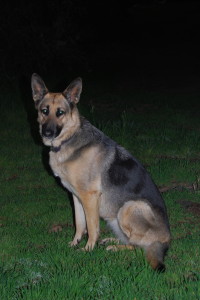 I lost my beloved German shepherd Grushenka a couple of weeks ago, the family having made the decision to end what increasingly seemed like a hopeless string of hospital visits, unwelcomed medications and transfusions. She was only seven or eight years old, much too brief a lifetime; at least too soon to say goodbye to that extraordinary, powerful spirit of hers. We were all so blessed with her presence, and now, out of that sadness arises gratitude for all the joy and complexity she brought to those around her.
I lost my beloved German shepherd Grushenka a couple of weeks ago, the family having made the decision to end what increasingly seemed like a hopeless string of hospital visits, unwelcomed medications and transfusions. She was only seven or eight years old, much too brief a lifetime; at least too soon to say goodbye to that extraordinary, powerful spirit of hers. We were all so blessed with her presence, and now, out of that sadness arises gratitude for all the joy and complexity she brought to those around her.
Certainly, none of us get out of this life alive, and I’m sure most of my readers have had many losses in their lives. Nearly all pilots have known fellow pilots, as well as friends and family, who have “gone west.” Death seems to come in waves, and I’m all too rapidly approaching the age my parents reached when their friends and family members seemed to die off one after another. I talked to my father about how hard it must have been for him, outliving so many of them. He was a very sensitive and emotional man, but after a while he became inured to it. I remember when he heard the news about one of his friend’s passing, he just mildly shrugged, said a brief “hmm,” and went about his business. At some point, I suppose, it all becomes too much.
There is no way to truly understand death, at least not scientifically. Science can explain certain aspects of it, but science is ill-equipped to handle the big questions, especially those having to do with consciousness, and what happened before and what happens afterward. All we really have to understand death are narratives and metaphors.
Sometimes I think about life as if it were the rectangular pattern around an airport. Grushenka was a rescue dog, so I have no idea how she entered the pattern. She had a rough upwind leg, struggling with two TPLO (knee joint) implants, but she recovered well, and eventually had a smooth downwind leg, carefree with the wind at her back.
Turning base, she somehow developed an autoimmune disorder, and her red blood cells were constantly being attacked. For a while, there was some hope, with steroids and transfusions, and she was fighting the crosswinds well. But eventually, turning final, the headwinds were too much for her, and she seemed to be giving up the fight. Her landing was forced, as a pilot might say, but the euthanasia, surrounded by her doting family on the spot where she stood guard over the house, made it a good one. Sadly, this was the one she couldn’t walk away from.

